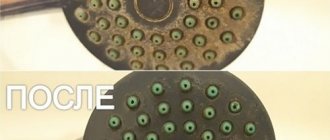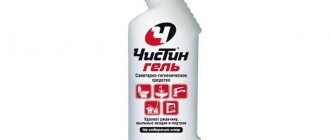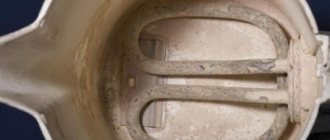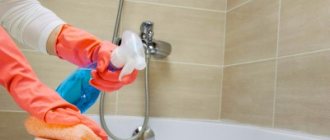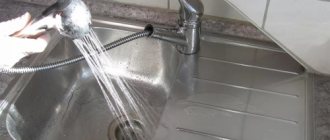If an acute problem arises, how to clean the shower head from limescale, you can use strong chemicals or improvised means. When used correctly, both methods can quickly remove water stone from the external surface of the device, as well as nozzles and internal elements.
You can clean the shower head with special preparations or improvised means.
Solutions to the problem
The best quality option is to use household chemicals. It is a special detergent containing certain active substances (most often chlorine), which can almost completely eliminate plaque. The cleaning process goes as follows:
- First of all, you need to disassemble the watering can. It is advisable to have its operating instructions for this (good models have them included). When the device cannot be disassembled, you should not overdo it, because it can simply be broken. If your option is not collapsible, this item should be skipped.
- First, wipe the watering can itself using detergents. In some cases this helps, and in others it doesn't. The reason for this is the accumulated small particles in the nozzles, which clog the water supply holes. In this regard, in order to eliminate them, it will be necessary to pre-soak.
- To carry out this procedure, you need to pour a little water into a basin, and then add a certain amount of detergent;
- After this, you need to lower the watering can itself into this container and leave it for a couple of hours. During this time, there will be a gradual destruction of the limestone deposits in it.
- Next, you need to brush directly over the watering can to remove any residue.
- After this, you need to rinse the device under the tap and wipe it dry. That's it, now the device can be installed and used.
This option is the most effective method for removing all accumulated limestone deposits and scale from the watering can. However, good commercial cleaning products may not always be at hand.
Therefore, you can use the methods that our grandmothers used in their time
When using household chemicals, do not forget about the necessary precautions. Before starting to process the shower element, you must wear gloves to prevent chemical burns to the skin.
Prevention Tips
When cleaning the watering can, it is important to remove even small deposits of stone. In places where plaque remains, the stone will rapidly accumulate again. The device should be washed at least once every 2 weeks. Minor stains can be quickly removed with any type of cleaning products. To reduce the rate of accumulation of water stone, it is recommended to install special filters that trap substances that form plaque.
When using chemical compounds, all necessary precautions must be taken. The active substances they contain can cause a strong burning sensation if they come into contact with the skin, so gloves should be worn when cleaning the watering can. In addition, they can provoke attacks of suffocation, so when using them, you need to provide additional air flow into the bathroom. To protect the respiratory system, it is recommended to use a respirator.
Oxalic acid
Oxalic acid is sold in pharmacies. It will quickly and effectively remove lime deposits.
Algorithm of actions:
- Preparation of the solution: dilute 2 tbsp in 1 liter of warm water. l. oxalic acid. The liquid should be slightly warm, so the product will dissolve better.
- Leave the watering can in the solution for 2–3 hours.
- Then take a brush and clean all the holes.
- At the end, it is necessary to wash off the remaining oxalic acid with clean water.
Work with this product using rubber gloves. Oxalic acid acts aggressively, so its use should be used very rarely and as a last resort.
It is better to use more gentle cleaning methods, such as citric acid or vinegar.
Lemon acid
This cleaner also contains acid that can destroy limescale deposits. Lemon cleanses perfectly any dirt, including plaque.
How to clean a shower head - step by step instructions:
- The device is disassembled and all the parts are placed in a deep pan, which you don’t mind using for boiling.
- The elements are covered with citric acid. 1 sachet is enough. If the plaque has covered all the parts and there is a lot of it, then use 2 sachets of citric acid or more. Look at the degree of contamination.
- Fill everything with water. The liquid should cover all parts. You can leave the watering can languishes in the solution for 20 minutes, or you can boil it for 10 minutes, and the process of removing limescale will also go faster. The citric acid will react with the deposits and a lot of bubbles will appear. This way plaque is removed.
- Wait until the water cools down. Remove the device from the water and clean each part with a stiff-bristled toothbrush.
- Rinse the watering can with water, assemble, dry and polish until shiny.
Citric acid effortlessly removes all limescale deposits. This method can be used several times a month. Shower heads made of any material can be cleaned, except for plastic parts, if boiling is necessary.
Causes of pollution
The main reason for the formation of limescale lies in the increased hardness of the water.
The water contains impurities of calcium, heavy metals and other substances from which deposits are formed. High water temperature promotes the activation of plaque formation.
In addition, the rate at which lime deposits appear inside the watering can is affected by the pressure in the water supply network - the lower it is, the lower the pressure. Because of this, the compounds contained in the water are not washed off, but settle on the internal surfaces of the pipes.
Certain design features of plumbing fixtures and piping may contribute to the formation of limescale. Often the occurrence of such a problem is the result of a combination of these factors.
Disassembling the shower head
The main blockages accumulate inside the shower, and insoluble deposits such as sand and rust can only be removed by disassembling. It is advisable to carry it out only in case of severe blockage. Before starting the process, you need to make sure that the design of the device allows this to be done, since there are models that cannot be disassembled.
Disassembly includes the following steps:
- Disconnecting the watering can from the hose.
- Removing the decorative plug in the center of the divider.
- Unscrewing the screw using a Phillips or flat-head screwdriver.
- Separation of internal parts from the body.
When disassembling complex structures, such as a tropical shower shower cabin, it is better to carefully study the instructions, which must be included in the delivery kit of the plumbing equipment.
After final disassembly, you can begin mechanical cleaning, which includes cleaning the fine mesh with a brush and removing possible insoluble particles from the body and nozzles of the shower head.
Removing limescale from faucets using vinegar
You need to take:
- gloves
- 7% vinegar,
- old toothbrush
- wire or paper clip
- a basin with a rag to remove deposits
When choosing vinegar, be careful not to confuse it with concentrated vinegar essence, which will immediately corrode the shower coating.
- First, remove the shower head. If this is difficult, use pliers, but be sure to wrap a cloth around the reflective surface of the plumbing first to prevent scratches. If possible, remove the shiny cover and leave only the shower head.
- Place the shower head in a bowl of vinegar heated to 50 degrees. Don't forget to wear gloves.
- If you can’t remove the faucet, experienced housewives advise pouring vinegar into a plastic bag and putting the faucet there. The shower nozzles must be completely submerged in vinegar. Secure the bag with a paper clip or wire. Soak the plumbing fixtures in vinegar for 15-20 minutes.
- After soaking, limescale deposits simply need to be brushed off with a stiff-bristled brush.
- Next, rinse the treated plumbing fixtures in hot water.
This simple folk recipe will help remove lime from the surface of the shower head.
To remove lime deposits from a faucet, you can use the following tips from housewives:
Coca Cola
Coca-Cola will also work for cleaning a shower head. To restore pristine cleanliness, you just need to dip it whole or disassembled into parts in a warm drink for 30-60 minutes, and then rinse with water. If the blockages are very noticeable, you can slightly warm up the cola. This way it will quickly corrode plaque and stone.
Important! Soda is very aggressive, for this reason it is not recommended to keep a watering can in it for more than an hour.
The list of cleansing properties of the drink is extensive: from tea stains in a thermos to rust from a cast iron frying pan.
Chemical cleaning
There are areas from which contamination cannot be removed by mechanical cleaning.
In such cases, you should use soaking the shower head in various chemical solutions. If the device does not imply separation from the hose, you can pour the solution into a plastic bag and put it on the watering can, securing it with electrical tape or tape. Scale dissolves in various acids, and it is not at all necessary to use expensive store-bought substances; you can get by with improvised means that are often found in everyday life.
Lemon acid
To dissolve scale with its help, you will need 25 g of powder, which is the standard size of a pack of acid.
The contents of the sachet should be diluted with about a liter of hot water. After this, a shower head is placed in the solution for about 20-30 minutes. Leaving it for a longer period is not recommended, since citric acid concentrate can damage plastic parts. After the plaque has softened, it is removed using a soft cloth or toothbrush.
Using Vinegar
Acetic acid will help remove limescale from your shower head.
To soften the water stone, you need to keep the watering can in the solution for several hours. 9% table vinegar does not need to be diluted. Vinegar essence is diluted in the proportion of 1 part vinegar to 6 parts water. The holding time of the shower head in the solution depends on the degree of clogging; to speed up the process of softening the scale, the solution can be heated. It would be ideal to leave the watering can in a vinegar solution overnight, then clean it under running water using a brush.
Professional products
When using specialized descaling products, cleaning will take less time and effort than using household chemicals. The price of such products will be higher, but they have a number of advantages:
- Specialized products do not damage the surface, unlike a concentrated solution of citric acid and vinegar.
- Better scale dissolution.
- Economical consumption.
- It takes much less time to remove plaque.
Preparing the Sprayer for Cleaning
Over time, limescale deposits appear on the shower head, causing water to flow poorly.
Visible dirt is only part of the problem. If you only wash the outside of the watering can, soon the entire internal passage will be clogged with water stone. For proper cleaning, it is advisable to disassemble the product to get to all hard-to-reach places. Check the instructions to see if it is possible to unscrew the sprayer and how to do it correctly. Work carefully, the design contains thin rubber gaskets; the metal can be damaged if subjected to strong pressure with a rough wrench.
It is recommended to regularly clean the outside of the shower screen, and disassemble it only when dirt begins to accumulate inside. The frequency of procedures depends on the quality of tap water. If brown liquid is flowing from the pipes, you will have to flush it very often. When high-quality liquid from an artesian well enters the system, the shower may not become clogged for decades. On average, it is recommended to carry out external cleaning once every 2-3 months, and washing with disassembly annually. To determine the degree of contamination, open the faucet to high pressure and see if jets are coming out of all the holes.
If the sprayer cannot be disassembled, disconnect it from the hose. To do this, you just need to unscrew the nut at the base of the watering can. There are times when the connection is rusted or covered with limescale, and it is impossible to unscrew it. Even in this situation, you can clean out the old shower attached to the metal tube. In this case, the work will have to be carried out in the bathroom; make sure that none of the family members douse themselves with the cleaning composition.
Sometimes the atomizer cannot be taken apart because all the joints are covered with water stone. After cleaning, try to unscrew it again, if possible, clean the threads, fasteners and other parts from plaque. Lubricate the rusty areas and assemble the sprayer. Next time you can easily unscrew all the screws and nuts.
When purchasing a new watering can, choose only collapsible models; they are easier to remove from internal contamination.
Vinegar
You can clean the shower head from plaque using table vinegar. Deposits soften under the influence of acid and are easier to remove.
How to clean a shower head with disassembly:
- Disconnect the shower head from the hose and disassemble the shower head. If you don't know how to do this, check the instruction manual. If you recently installed a new shower head and it is under warranty, make sure you remove it according to the instructions on the package.
- Find a container or basin large enough to completely submerge the shower head. Fill the container with a sufficient amount of white vinegar. Take a small container, oblong and low, this way you can reduce the amount of cleaning agent.
- Leave the shower head in the solution for 1 hour. If a deeper clean is required, you can leave it in the product overnight. If your shower head is made of metal, you can boil it in vinegar for 15 minutes. If it is made of brass, nickel or gold plated, leave it in vinegar essence for 30 minutes.
- Remove the device from the container and rinse under running water.
- Do not discard the remaining solution. Take an old toothbrush and give the entire device a good scrub. Focus on the base where the holes are located. This is where the largest amount of sediment accumulates. Clean until all the insides are sparkling clean.
After rinsing the shower head with clean water, use a soft cloth to polish. You can take microfiber or flannel material. Polish the structure until it is completely dry.
Then assemble all the parts and put the shower head in place.
How to descale a shower head with vinegar without disassembling:
- Pour white vinegar into a plastic bag. Take enough to completely cover the shower head. Make sure the bag has no holes and can support the weight of the vinegar for a long period of time.
- Add baking soda. There should be twice as much vinegar. A reaction should begin and the product will bubble.
- Lift the plastic bag towards the shower head until it is completely submerged in the solution.
- Secure the bag with tape, rubber band, or a hair tie. Make sure the polyethylene is well tied and will not slip off.
- Wait one hour. You can leave the vinegar packet on the watering can overnight for a deeper clean. The longer you leave the product to work, the cleaner the device will be.
- Remove the plastic bag. Throw it away. Turn on the water supply to the shower. Leave it on until all the product is removed and the vinegar no longer smells.
If the process needs to be accelerated, before putting the plastic bag on the watering can, it can be heated or even boiled. The smell will be unpleasant and pungent, so wear a respirator or medical mask.
Spot cleaning with vinegar: The shower head does not need to be removed or disassembled. To do this, you need to moisten the toothbrush in vinegar, then in baking soda and begin to clean the mesh.
Pay attention to the hose itself and the screw that connects the watering can to the hose. They can also be cleaned this way.
Once cleaning is complete, run the shower head into water to remove excess vinegar and sediment. Don't worry about the smell, it will go away over time. Turn on the water supply and rinse the inside of the device.
Store-bought descalers
There are many different chemicals available to remove plaque from plumbing fixtures. Antiscaling, an inexpensive chemical, will help remove plaque from your shower head. It is used for those materials that are resistant to high temperatures, since this cleaning method requires boiling the parts in water.
There are more modern formulas and cleaners that can help clear your shower head of limescale and residue buildup. Perfect for:
- Sillit Bang;
- Sif;
- Sanox;
- Electrolux.
Domestos is also suitable for cleaning watering cans made of different materials; it is a universal cleaner and helps to perfectly remove plaque.
For more advanced situations, the strong chemical formula WD-40 is suitable.
There are many other means with which you can very carefully and accurately remove plaque. They also form a protective film that prevents scale formation.
Before purchasing and using any product, carefully read the instructions for use.
Use standard precautions: look at the expiration date and contraindications. The most susceptible surfaces are:
- acrylic;
- chrome plated;
- made of brass;
They must be used very carefully and protected from exposure to highly concentrated products, which should only be used when the degree of contamination is very high.
Disassembly
To better clean the device, you need to disassemble it. This will help remove limescale in all hard-to-reach places.
You will need a wrench and a soft non-slip cloth, a screwdriver and a knife.
What to do:
- Remove the shower head by turning it counterclockwise. If there is a nut, use a wrench (do not use pliers as this may damage the finish).
- First you need to remove the plug; it is located in the center of the mesh. It will be difficult to remove it with your hands, try picking it up with a knife.
- There is a screw under the plug; you unscrew it with a screwdriver.
- Then carefully remove the mesh so as not to damage the rubber gasket and begin cleaning.
If you can’t disassemble the shower head, it’s not a big deal. You can clean the mesh without disassembling it.
Taking apart the shower
Before cleaning the shower head from scale, disassemble it very carefully and carefully. You can do this with a screwdriver, a knife and a gas wrench. What to do:
- using a gas wrench, unscrew the connecting washer and remove the watering can from the flexible hose;
- using a knife, easily pick up and disconnect the central plug;
- There will be a screw under the plug. Unscrew it with a screwdriver. If it is covered with deposits and salt, try to clean the threads as carefully as possible.
Proceed with extreme caution, as over time, salt and lime deposits accumulate at the joints, which can greatly hinder the disassembly process.
All the elements are in front of you: handle, mesh and gasket. To check the hose for deposits inside, disconnect it from the faucet.
Cleaning with improvised means
Everything that every housewife should always have on hand can be used as improvised means:
Vinegar. It can be used to remove any type of contaminant, in particular limestone deposits.
However, it is important to dilute 70% vinegar essence in water in order not to damage the coating of the watering can itself. For this purpose the consistency should be 1 to 20
If you use 10% table vinegar, it will be enough to dilute it with water in a ratio of 1 to 1. To achieve better efficiency, you need to heat the resulting solution. After this, you need to lower the watering can into the resulting solution and, after a certain time, remove it, brush and rinse.
Lemon. Since lime is afraid of any acid, citric acid can also be used to eliminate it. To do this, you need to pour up to 50 grams of citric acid into one liter of water, then place a watering can. You can also use freshly squeezed lemon juice. After a certain time, you also need to clean and dry the watering can.
Baby oil. This may sound strange, but oil for children contains those components that allow you to dissolve limestone deposits. To do this, you need to take a cloth, soak it in this product, and then use it to treat all the holes of the watering can, leaving it for a couple of hours. After this time, you need to use a brush to remove all remaining plaque and rinse with water.
Oxalic acid. Such a remedy is very aggressive, so its use should only be in cases where conventional methods simply cannot cope. You can buy it in regular pharmacies. So, for one liter of water you need to dissolve a couple of tablespoons of acid, then place a watering can in the container with the solution. If sufficiently large or old elements of limestone plaque are present, the concentration of oxalic acid must be increased to eliminate them. When the soaking process is finished, you need to clean the nozzles using a regular toothbrush. This will remove even small plaque particles.
Baking soda, vinegar, and ammonia. This type of product, in addition to allowing for cleaning of lime deposits, also eliminates the possible appearance of various fungal spores. To create the necessary solution, you need to take half a glass of vinegar, add a few tablespoons of soda, as well as 150 ml of ammonia. This is all mixed, after which it is heated to 50 degrees. After this, the watering can is lowered into this solution and left there for one hour, then washed, and the device is ready for use.
To avoid having to get rid of limestone deposits, it is necessary to carry out preventive measures in a timely manner. In this case, the plumbing will work for a long time.
How to easily remove plaque from plumbing fixtures, see the tips in the following video:
Anti-plaque household chemicals
Chemicals that contain chlorine or other aggressive substances are good at removing limestone deposits.
Detergents are often used for cleaning and are used to combat stains in the toilet and bathroom.
Effective compositions include:
- "Domestos";
- "Silit Beng";
- "Toilet duckling";
- "Mr. Muscle", etc.
If the plaque is insignificant, all parts of the watering can are treated with any of these products and left for 15 minutes. Then the elements need to be cleaned with a stiff toothbrush and rinsed. If necessary, the procedure is repeated.
All parts of the watering can are treated with Domestos.
If the elements have a thick coating of water stone, it is better to soak them before cleaning them. All parts of the watering can are placed in a basin with 5 liters of hot water and 1 glass of the selected product is added. It is advisable to cover the container with a lid or towel. The parts are soaked in the solution for 12 hours. They are then cleaned and washed. This method allows you to remove water stone from the inside of the hose.
How to clean a shower head with improvised means
- Vinegar.
It perfectly fights against any pollution, and especially against limescale. If you have 70% vinegar essence, you must dilute it with water so as not to spoil the coating of the watering can. Dissolve the essence 1:20. If you use regular table vinegar 10%, you can dilute it half and half with water. The prepared vinegar solution must be heated for greater effectiveness. Dip a watering can into the warm solution and leave for a while. After this, clean the watering can with a brush and rinse thoroughly. - Lemon.
Lime is afraid of acid, including citric acid. Dissolve three sachets of citric acid (10-15 grams each) in a liter of water and dip a shower head into the solution. You can also pour pure natural lemon juice over the watering can. After this, leave the watering can so that the plaque dissolves, and after a while, rinse it. - Baby oil.
Oddly enough, baby oils contain substances that can dissolve limescale. Pour a little oil onto a cloth and wipe all areas with limescale with it. Carefully treat all nozzles and leave the watering can for several hours. After this, clean off the remaining plaque with a brush and rinse the shower with soapy water. This is done so that no greasy traces remain from the oil. - Oxalic acid.
This is a fairly aggressive remedy that should be used when other methods do not help. Oxalic acid is sold in pharmacies and is very aggressive. Dissolve two tablespoons of powder in a liter of water and dip a shower head into the solution. For large and old pockets of limescale, the acid concentration must be increased. After soaking, brush the jets with an old toothbrush to clean all the small, hard-to-reach areas. - Baking soda, ammonia, vinegar.
This product will not only clean the shower head of limescale, but will also disinfect surfaces and get rid of possible fungal spores. For a liter of water you will need half a glass of vinegar, three tablespoons of baking soda and three bottles of ammonia (50 ml each). Everything needs to be mixed and heated to 50-60 degrees. Dip the shower head into the hot solution and leave for 40 minutes. After this, rinse all plumbing fixtures with warm water and wipe dry.
When using household chemicals (professional or home), do not forget about precautions. Be sure to wear gloves to avoid burning your skin and a respiratory mask to avoid poisoning by chlorine and vinegar fumes
Any housewife dreams of every corner of her home looking perfect. This is not difficult to achieve. In order not to suffer, getting rid of complex old stains and limescale, you need to do preventive cleaning on time. And then your plumbing will shine!
Best answers
BASIL:
if the pressure from the shower tap is good, then try replacing the watering can itself
Vladimir Kovalkov:
There is this plastic pipe in the shower - throw it out and put a gasket in it
mood color:
The shower is clogged. We need to change it.
The holes in the watering can are clogged.
Grandfather Au:
Sometimes it's a matter of the watering can, as they said. Unscrew the watering can from the hose and check the pressure from the hose; if it is normal, remove the cap in the middle and unscrew the grille. if there is no pressure from the hose, the problem is in the switch, you need to look at the spool. By the way, there are also switches on the watering can
Spitz Pomeranian:
The problem is in the watering can, or rather, that the holes in the watering can have increased and the pressure has dropped. This happens when the watering can is old and you decide to clean the limescale. As a result of cleaning, the rubber nozzles of the watering can break off and the holes become larger. In this case, CHANGE THE WASHER.
Stas Shabanov:
When installing a mixer, sometimes they put gaskets with a mesh, they are probably clogged. Turn on the cold one first, then the hot one, if the pressure is different, then this is the probable reason
Galina Bogomolova:
Almost always like this. Change the watering can. You can buy it for 100 rubles. (It could have been cheaper, but I’m making allowances for the crisis).
Elektriker (DIXI!I):
watering can, hose section is small
Mikhail Podvolotsky:
There may not even be a blockage. It's a matter of design. Imported ones are designed for high pressure (up to 2 atm), but according to old standards, houses were calculated at 0.3-0.5 atm. Change the watering can. And look at the mixer's passport to see what pressure is needed for a normal spout.
Cleaning Rules
To clean the sprayer as completely as possible, for example, to carry out subsequent repairs to a shower head, you must:
- apply the selected cleaning agent to the surface of all components (if slightly dirty) or soak the elements included in the equipment for a certain period of time;
- Clean the surfaces with a stiff brush (you can use a toothbrush);
Cleaning with a stiff brush
- if necessary, additionally clean the nozzle holes with a toothpick or other sharp object;
- rinse under running water;
- Wipe the shower head elements with a soft cloth to avoid the formation of streaks.
Removing stains from the device body
Required Tools
To care for your shower stall, you will need tools that will provide high-quality, but gentle cleaning, and also save effort and time. In order not to damage the surfaces, do not use hard brushes, especially metal brushes, for cleaning, preferring soft ones.
Soft cloth and microfiber
Solutions and mixtures are applied with a cloth to soften deposits; the rag soaked in the solution is left for some time to act. The same tool is used for subsequent removal of detergents, wiping walls and trays, and wiping surfaces dry with a dry cloth. A microfiber cloth perfectly removes drops, which will help avoid dirt marks where they dry.
Spray
Used for spraying cleaning products, including homemade ones, onto walls, doors, trays and hard-to-reach places. Suitable for liquid mixtures only.
A rubber scraper is convenient for removing plaque from glass walls. Optimal because it does not leave scratches.
Foam sponge
The sponge is used to apply cleaning products, wipe off dirt with the rough side after exposure, and also wash off the residue. A soft sponge will not damage the surface of the shower stall.
Toothbrush
Relatively soft bristles are suitable for rubbing small stains and are convenient for processing seams and joints. On large surfaces, scrubbing surfaces is labor-intensive.
Other Home Remedies for Cleaning Watering Cans
Not everyone knows how to clean a shower head from scale using products that are found in every home, so you should familiarize yourself with the issue in more detail. Let's look at the components that can be used to remove limescale:
Lemon. Previously, we found out that various formations are destroyed after contact with acid, including citric acid. To prepare the mixture, we will need 1 liter of water and 3 packets of citric acid (each of them contains 15 grams), mix thoroughly. After dissolving the acid, you can lower the shower head into the container, it is important that the liquid completely covers all the elements, it is advisable to immerse the watering can disassembled . In this case, it is better to put the rubber pad aside so that the acid does not destroy its structure. Natural lemon has no less effective properties, so you can drip lemon juice onto the surface. After some time (at least 20 minutes), the dissolved plaque should be removed and the watering can collected. Baby oil. For some, it will be surprising to know that baby oil contains components that do an excellent job of removing limescale. To do this, we need to pour a certain amount onto a piece of cloth, and then wipe the surface with plaque. This must be done carefully, you can even pour a certain amount into the internal cavity, but to do this you need to disassemble the device. After treatment, leave the watering can for several hours so that the active components penetrate deep into the structure and break down the lime. Next, you can remove the residue with a brush, and then wash the device with a solution of warm water and soap. Such manipulations allow you to remove traces of fatty oil. Oxalic acid. This product has a fairly aggressive environment, so it should be used only if other methods have not been effective
Oxalic acid is sold in pharmacies; you should work with the substance with extreme caution, using protective elements. To prepare the solution you will need 1 liter of water and 2 tbsp.
spoons of acid in powder form, these components are thoroughly mixed until dissolved. If the affected area is large and the watering can has been cleaned for a long time, then you can increase the concentration of the product. We immerse the watering can in a container with the solution for a while, after which the surface is cleaned with a brush. It is important to pay attention to hard-to-reach places; it is necessary that there are not even small deposits left, otherwise cleaning will be ineffective. Baking soda, vinegar, ammonia. This solution allows you not only to remove limescale and other formations, but also to cope with pathogenic microorganisms, for example, fungus. To prepare, add 150 ml of ammonia, 0.5 cups of vinegar and 3 tbsp to 1 liter of water. spoons of soda. This mixture is thoroughly mixed and heated to 60 degrees. The watering can must be immersed in this solution for at least 40 minutes. Then the plumbing is washed with warm water and wiped dry.
Regular cleaning of plumbing fixtures allows you to extend the life of its use, and this, in turn, saves money. Now you know how to properly clean your shower head using home remedies. It is not at all necessary to buy expensive household chemicals, since they have the same effectiveness as the components that are in every home, but are much cheaper. It has been proven that some professional household chemicals cope with stains worse than, for example, vinegar or oxalic acid.
The most popular store-bought cleaners
Choosing effective cleaning products for your shower stall is not an easy task. But it’s not easy because there are a lot of different products on the market today. And your eyes just run wild when you need to choose one thing. But, nevertheless, there are time-tested and proven products on the positive side, such as:
- Dishwashing detergents - effectively remove traces of soap scum. In addition to liquid formulations, in some cases “Komet”, “Pemolux” and other powders are acceptable.
- So-called fungicides are means for removing black plaque and mold.
Toilet treatment products - can help clean, for example, the Toilet Ducky stone pan can be a lifesaver for those who have very hard water. Anti-scale agents for teapots. Antiscale solution will help get rid of limescale. Cleaning products for mirrors and glass
It doesn’t matter what it will be - “Mr. Muscle” or some other composition. Many of them are excellent at cleaning windows and mirrors. Melamine sponge
This is an almost universal product that can effectively remove dirt.
Popular detergents that can be used to clean the hydrobox:
"Akrilan" is a special product designed for cleaning acrylic surfaces. Cilit is a powerful product that should not be used on natural stone or aluminum surfaces. Quite poisonous
Requires extreme caution in handling. Tilex is a prophylactic agent. Used after taking a shower to prevent the formation of plaque and mold.
- Cif is a well-proven remedy. Can clean acrylic surfaces.
- “Sanelit” has a pungent odor, but at the same time copes well with the assigned tasks. Suitable for cleaning acrylic.
- Aron – effectively cleans hydrobox glass. Can be purchased at an affordable price.
- Sarma, Domestos, OC Plus and many other wonderful products.
